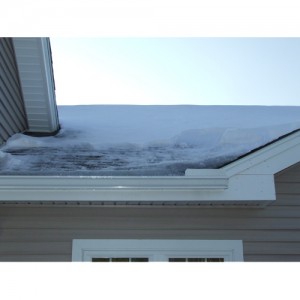Some Ice Dams Are Difficult To Prevent
 Ice Dams
Ice Dams
I’ve written several about how to prevent ice dams and how ice dams can damage your home. And typically I write about how you can prevent ice dams with better attic insulation and ventilation.
Ice dams are created when snow and ice melt further up the roof and run down towards the roof eave. As the melted water reaches the roof eave it starts to freeze on the cooler roofs edge. As the cycle continues the ice builds up and creates a dam that collects the melting water behind it, thus the term “Ice Dam“.
Ice Dams On New Homes
Conventional wisdom would say that ice dams really shouldn’t occur on newly built homes. This is especially true when proper insulation and ventilation are used. The photo shows a new home that has R45 attic insulation and proper soffit vents and ridge vents. So why does this newly constructed home have an ice dam?
Obviously we don’t live in a perfect world and not all homes are alike. This house has several converging roof planes with valleys. The picture actually shows an area on the rear of the house where a large valley carries the main roof area onto the smaller area shown. In addition, this smaller roof is adjacent to a large gable wall from the garage. This particular section of roof never gets direct sunlight during the winter months. The area is shaded by the large gable wall to the left and the roof is on the north side of the building.
Here’s my opinion about what is causing this unusual ice dam to occur. On sunny days the snow on the main roof line starts to melt (the upper portion of the main roof does get direct sunlight). As the melting water run downs the roof it ends up on the lower roof that is not exposed to direct sunlight and is therefore much cooler. At this point the ice dam forms just as it normally would. The difference in this situation is the snow starts to melt from the sun and not from heat escaping the house.
Ice Dam Solution
For this house we’ve recommended that the home owner use an ice melting tape to reduce the ice dams. There are many different snow melting cables on the market and they are really easy to install. Snow melting cables are a great way to prevent ice dams in difficult areas like the one at this house. Just remember to follow the instructions and consult with an electrician if yo’ure not sure about the proper power supply. Most snow melting cables come with a built in thermostat to turn them on and off depending on the temperatures outside.













If you have never used an ice melt sock before you will find it is a safe, efficient, quick, and preventative solution for ice dams. Fill an ice melt sock with with calcium chloride snow melt sock ice melt and lay it across the dam. If will help to melt the dam and also keep that area of the roof clear until the next good rain or thaw. DO NOT USE ROCK SALT… it will stain the roof and siding!